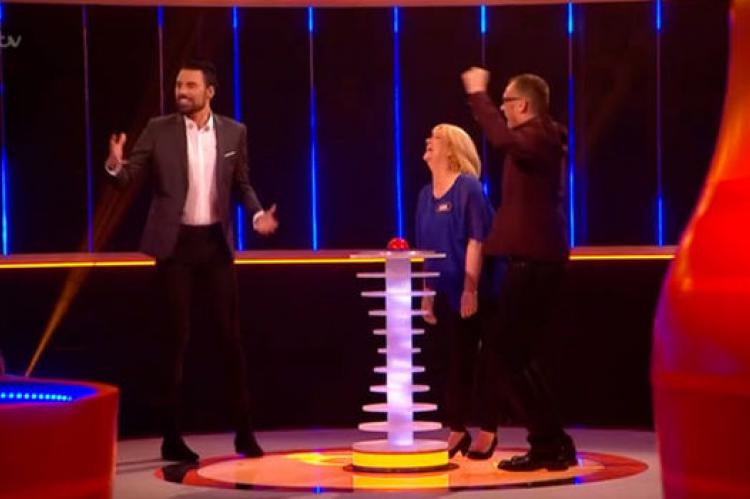Babushka is too slow and repetitive
Babushka is the latest in a long line of ITV’s teatime quiz show trials. Serves mainly to break up the monotony of The Chase for a few weeks, Babushka is, as you’ll probably gather, a game based around the Russian doll, a wooden figure which has several smaller versions of itself inside
By Matthew Gormley @MatthewPGormley
Babushka is the latest in a long line of ITV’s teatime quiz show trials. Serves mainly to break up the monotony of The Chase for a few weeks, Babushka is, as you’ll probably gather, a game based around the Russian doll, a wooden figure which has several smaller versions of itself inside.
Former X Factor reject Rylan Cark-Neal is your host. He’s done absurdly well for himself since he was the token joke act of the 2012 series. Thankfully, he’s come a long way since his melodramatic crying at Nicole Sherzinger’s ‘Judges Houses’ round and, although he may be slightly wooden as a presenter, her has enough personality to carry off this, well, erm, wooden, format.
Combining elements of Deal or No Deal and Chris Tarrant’s, The Colour Of Money, it’s essentially a game of luck, but unlike Deal, a limited amount of general knowledge is required, as there are questions involved.
There are ten Babushka dolls, or matryoshka dolls to give them their proper name, all of which are given inventive Russian names, including Katya, Anastacia and Natalya. Inside eight of the dolls are differing cash prizes, ranging from £500 to £10,000, whilst two of them are empty.
At the beginning of each round, the two contestants, working together, must answer a general knowledge question from a selected category. A simple true or false answer is all that’s required, but naturally there’s at least a couple of minutes of heated discussion as the couple try to fathom out a ridiculously simple answer, such as whether or not there are two Bank Holidays in May.
“I’m pretty sure it’s the only month with two bank holidays”, Debbie boldly claimed. Er, what about Easter?
If they guess correctly, they can open the Babushka doll, layer by layer. The smaller the doll, the more money they’re worth. So, a doll containing £500 has only one inner layer, whereas a doll containing £10,000 has five hidden miniatures. The contestants can choose to push the button in the hope of revealing another doll and adding some more cash to their prize pot. However, if they go one step too far and reveal an empty doll, they lose everything they’ve currently got in the bank.
In fact, there’s a common theme of losing money throughout the whole show. Losing their cash when they take a risk is fair enough, but if, at any point in the game, they answer a question incorrectly, they also lose all their money. And, of course, if they happen to open one of the entirely empty dolls, guess what? They also lose everything. It seems a little harsh. The suspense of watching them open the dolls layer by layer was completely ruined by them constantly being stripped of their prize. By the time we were 45 minutes in, they still had no money behind them.
The contestants have three lifelines, which supposedly will help them actually keep some of their cash. They can ‘peak’ inside the doll that they currently have in play, meaning that, once they’ve decided to bank, they can continue to strip back the figures and see if they could have potentially won anything more. A typical ‘here’s what you could have had’ tease. Granted, this makes play slightly easier for the couples, as, by knowing the total value of one of the dolls, it helps eliminate one of amounts left on the board.
They can also choose to ditch one particular question and swap it for another one from an alternative category. Their third lifeline, X-Ray, is unlikely ever to see the light of day, given that the players have to accumulate £5,000 by the halfway stage in order to make use of it on their final doll.
The suspense that was created during the first two or three rounds quickly faded by the time we got to the fourth and fifth. It’s all too slow and repetitive. Round after round, it quickly becomes mundane: answer a question, open the doll, lose whatever money you’ve managed to build up. The tension created when they lose their money for the first time is dissipated when they blow the bank every opening every other doll.
The only change in the format comes at the very end when, after opening all ten dolls, they are given the option to double their cumulative winnings. But, in the true spirit of building ‘em up and knocking ‘em down, it’s all or nothing yet again. There are two final dolls, one black, one white. One is gold inside, the other is empty. If they pick the gold one, they double their money, if they pick the empty one, they leave with absolutely nothing. Debbie and Martin decided it wasn’t worth the risk, and who can blame them? After spending an hour being stripped of every bit of money you think you’ve won, the last thing you want to do is choose to gamble it all away in anti-climatic end game.
I do like the concept of Babushka. It may not be entirely original, but it’s fun. It’s just a shame the format has too many flaws. It lacked pace, it lacked suspense and, above all, it lacked thought.
Babushka continues weekdays at 5.00pm on ITV until Friday 26 May 2017.



